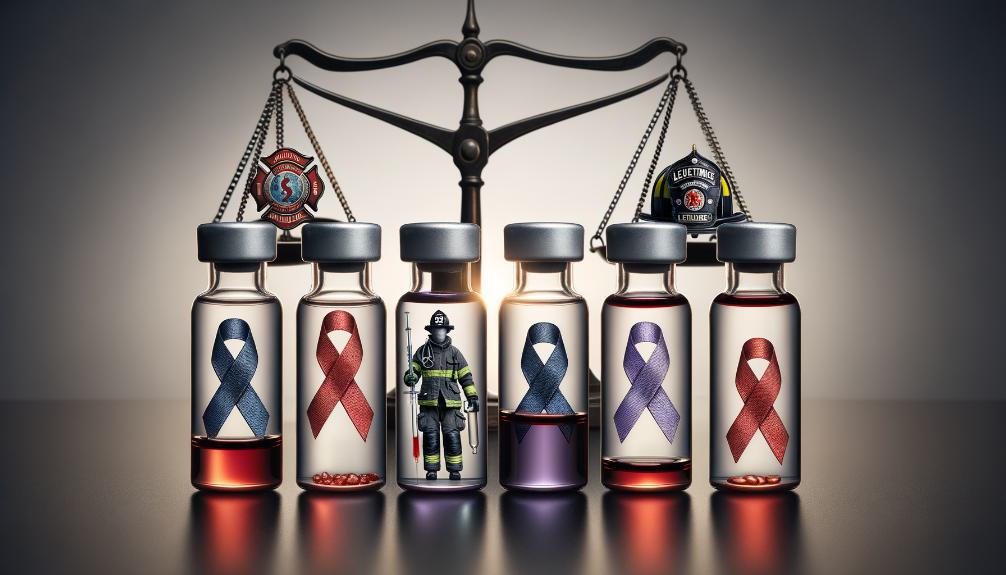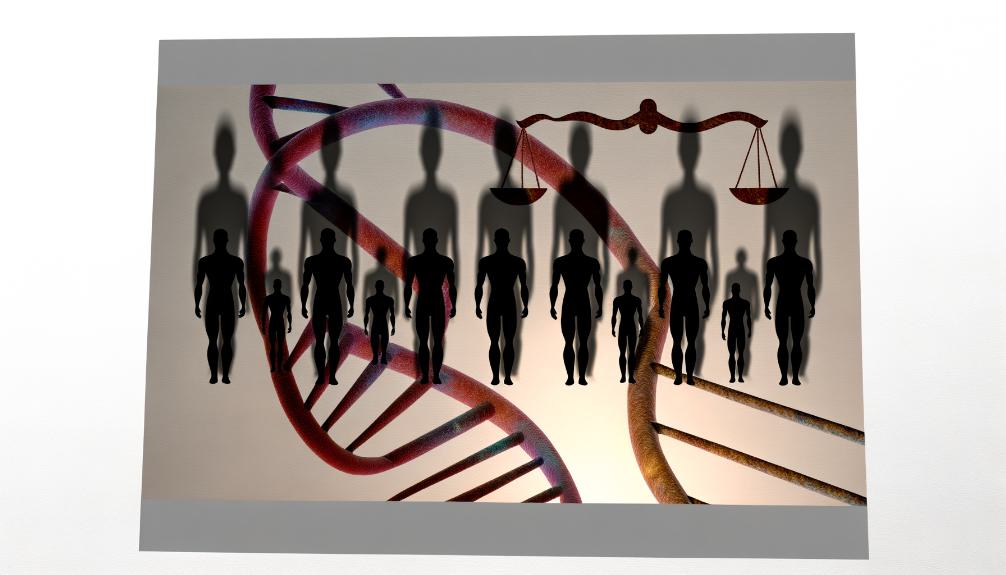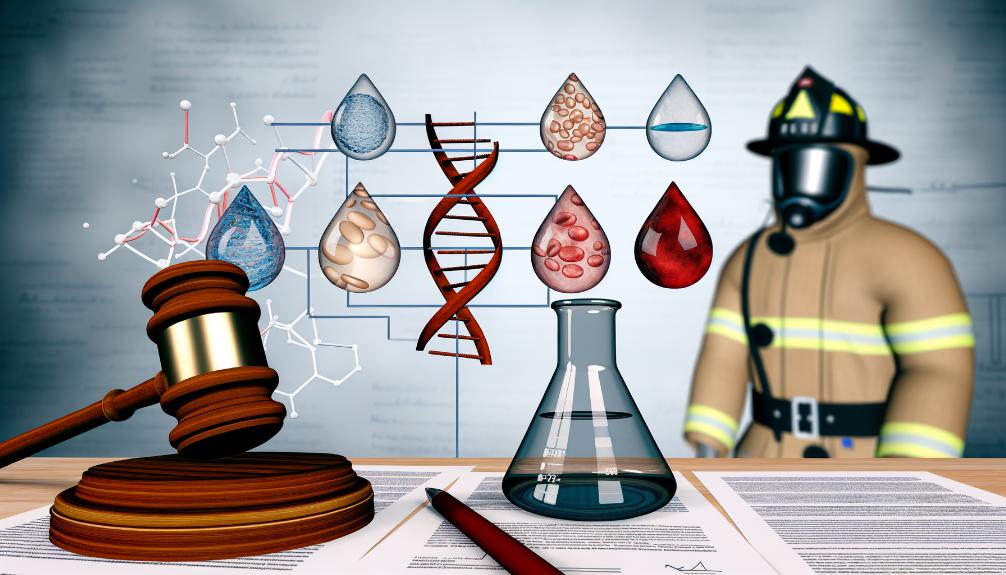Leukemia Types and Causes in AFFF Lawsuits
In addressing leukemia types and causes in AFFF lawsuits, we're highlighting myeloid and lymphoblastic leukemia, directly linked to AFFF exposure. AFFF, containing PFAS compounds like PFOA and PFOS, puts firefighters, among others, at a higher risk. The persistent nature of these compounds, labeled as 'forever chemicals,' greatly heightens cancer, particularly leukemia risks. Legal battles against manufacturers, including 3M and Dupont, aim to secure compensation for affected individuals, acknowledging the increased health risks. Firefighters and veterans, given their direct AFFF handling, face substantial leukemia risks. Understanding the importance of legal aid in these cases provides a pathway to justice and support for affected parties, offering insights into managing these legal complexities effectively.

Key Takeaways
- AFFF exposure is linked to myeloid and lymphoblastic leukemia types.
- PFAS compounds in AFFF, like PFOA and PFOS, increase leukemia risk.
- Firefighters and veterans with AFFF exposure are at higher leukemia risk.
- Legal actions target AFFF manufacturers for health risks, including leukemia.
- Specialized attorneys assist in claiming compensation for AFFF-related leukemia cases.
Understanding Leukemia

Leukemia is a type of cancer that affects the body's white blood cells and can be greatly influenced by exposure to AFFF. This disease disrupts the normal function of white blood cells, essential for fighting infections, by causing an overproduction of abnormal cells. Research has shown that AFFF exposure, particularly among firefighters, markedly increases the risk of developing various forms of leukemia, including myeloid and lymphoblastic types. These types of leukemia differ in the specific white blood cells they affect and their progression rates, yet both have been linked to AFFF exposure.
Understanding the risk factors associated with leukemia is critical, especially for those in occupations with high AFFF exposure. The latency period, typically around five years for leukemia resulting from AFFF exposure, indicates that symptoms might not appear immediately after contact with the substance. This delayed onset complicates diagnosis and treatment, underscoring the importance of regular health monitoring for those at risk.
Firefighters, who are frequently exposed to AFFF during the course of their duties, are particularly vulnerable. Their prolonged and repeated contact with AFFF heightens their risk of developing leukemia compared to the general population. This has led to a growing concern within the firefighting community and calls for better protective measures to mitigate the risk.
AFFF and Chemical Exposure
As we shift our focus to AFFF and chemical exposure, it's essential to understand the composition of AFFF and the health risks it poses. Research has identified PFAS chemicals as carcinogens, leading to increased legal scrutiny and lawsuits. We'll explore the implications of these findings and the ongoing legal battles to address the harm caused by AFFF exposure.
AFFF Chemical Composition
A key component of AFFF is the inclusion of perfluorooctanoic acid (PFOA) and perfluorooctanesulfonic acid (PFOS), known for their environmental persistence. These substances, part of a larger group known as PFAS (per- and polyfluoroalkyl substances), are often referred to as "forever chemicals" because of their ability to remain in the environment without breaking down. The use of PFOA and PFOS in AFFF has raised significant concerns due to their potential link to health issues, including cancer. The strong chemical bonds of these PFAS compounds mean they can accumulate in the human body over time, leading to long-term exposure risks. This has underscored the importance of increased awareness and regulation surrounding AFFF to mitigate potential health impacts.
Health Risks Identified
We've identified that exposure to AFFF and its PFAS compounds, including PFOA and PFOS, greatly increases the risk of developing leukemia among other health concerns. These chemicals, known carcinogens, have been linked to not only leukemia but also liver, kidney, and immunological effects that elevate the overall cancer risk. Firefighters, airport personnel, and oil refinery workers, due to their occupational exposure to these substances, are particularly at risk. Additionally, individuals residing near military bases and airports, where the use of AFFF is prevalent, face a heightened cancer risk, including leukemia, due to potential exposure to these harmful chemicals. It's important to understand the gravity of these health risks as we navigate the impacts of AFFF and PFAS exposure.
Legal Actions Underway
Understanding the serious health risks associated with AFFF and PFAS exposure, it's now important to focus on the legal battles that have emerged to address these concerns. Legal actions are underway against manufacturers like 3M, Chemguard, and Dupont for their roles in the widespread chemical exposure. These lawsuits aim to secure compensation for individuals who've developed health issues, including leukemia, due to exposure to PFAS-based firefighting foam, especially on military bases contaminated by these harmful chemicals. By holding these companies accountable, the legal proceedings aim to provide justice and support to those affected. It's a critical step in addressing the long-term impact of AFFF chemical exposure and ensuring that the parties responsible for endangering public health are held to account.
Leukemia Risk in Firefighters
Firefighters' exposure to AFFF markedly increases their risk of developing various types of leukemia. This alarming issue has come to the forefront as we investigate further into the impact of AFFF exposure, particularly in firefighters who are at the frontline. Studies have consistently shown that firefighters, due to their close contact with Aqueous Film Forming Foam (AFFF) during firefighting activities, face an increased risk of leukemia. This risk is not uniform but is notably higher in specific environments such as training sites and military hangars where AFFF usage is prevalent.
The types of leukemia associated with AFFF exposure in firefighters are varied, emphasizing the severity and breadth of the issue. It's clear that the nature of firefighting activities, including the direct handling of AFFF, contributes to this heightened risk. This connection between AFFF exposure and leukemia causes warrants serious attention, underscoring the need for regular health monitoring of firefighters. Such health monitoring is essential, not just for early detection but also for the effective management of leukemia risk among firefighters.
The discussion about leukemia risk in firefighters due to AFFF exposure is not merely academic. It has real-world implications, highlighting the importance of protective measures and health monitoring protocols. As we continue to explore the various facets of leukemia causes linked to AFFF, the well-being of our firefighters remains a priority. The insights gained from ongoing research and monitoring efforts are crucial in developing strategies to mitigate this increased risk.
Legal Eligibility and Claims

We're now turning our attention to the critical aspects of legal eligibility and claims in the context of AFFF lawsuits. Understanding the claim filing process and getting a clear overview of eligibility criteria are pivotal steps for individuals seeking justice and compensation for leukemia linked to AFFF exposure. It's essential for affected parties, especially those in high-risk occupations, to be aware of the legal avenues available to them.
Claim Filing Process
Handling the claim filing process for AFFF-related leukemia cases demands meeting specific legal eligibility criteria, and hiring specialized attorneys can greatly ease this journey. Our focus is on ensuring victims of AFFF exposure are well-informed about the importance of providing military and medical records. These documents are vital in substantiating the connection between AFFF exposure and leukemia claims. We offer a free consultation to help assess the viability of potential claim filings. Understanding that legal assistance is pivotal in maneuvering through the complexities of filing for compensation. Our team of specialized attorneys is dedicated to supporting victims through this process, aiming to secure the compensation they rightfully deserve for their suffering due to AFFF exposure.
Eligibility Criteria Overview
After addressing the claim filing process, it's important to understand who's eligible for AFFF lawsuits and the specific criteria they must meet. Individuals diagnosed with cancer due to PFAS exposure, particularly those in high-risk occupations like firefighters and military personnel, may qualify for compensation. The eligibility criteria often hinge on occupational exposure to toxic firefighting foam, underscoring the importance of documenting such exposure. Specific cancer types linked to PFAS exposure further refine eligibility for claims. Seeking legal assistance is vital in maneuvering the complexities of AFFF lawsuits. Experienced lawyers can assess if your case meets the eligibility criteria, helping secure the compensation deserved for those affected by exposure to hazardous substances in their line of duty.
Types of Leukemia From PFAS
Given the widespread use of AFFF containing PFAS, it's important to recognize that exposure can lead to several types of leukemia, including myeloid, lymphoblastic, acute, and chronic lymphocytic leukemia. These conditions are serious, with the diagnosis varying based on the aggressiveness of the disease and the specific cell types affected. We've seen an uptick in cases where individuals, particularly veterans, have been diagnosed with one of these leukemia types after being exposed to PFAS at military bases post-1966.
The link between PFAS exposure and leukemia cannot be overlooked. Studies suggest that those who've spent significant time on contaminated bases are at an increased risk of developing diseases such as chronic lymphocytic leukemia, acute lymphoblastic leukemia, and myeloid leukemia. This connection highlights the importance of understanding the risks associated with AFFF contamination. It's not just about recognizing the potential health implications but also about understanding the options for seeking compensation. Veterans and others who've been exposed to PFAS through AFFF and subsequently diagnosed with leukemia may be eligible to seek compensation for their conditions.
The risks of leukemia from PFAS exposure underline the need for those affected to be aware of the types of leukemia linked to these chemicals. Awareness is the first step towards seeking justice and compensation for the harm suffered. It's essential for those impacted to recognize the signs and understand the legal avenues available to them for redress, especially considering the lengthy latency periods associated with these types of cancers.
Seeking Legal Assistance

For those impacted by AFFF-related leukemia, seeking legal assistance from specialized attorneys can be an important step towards compensation. These legal experts are well-versed in handling AFFF-related leukemia claims, understanding the intricacies of such cases, and guiding individuals through the complex legal process. They'll help in assembling important documentation, such as military and medical records, which are essential in substantiating the link between AFFF exposure and leukemia.
Securing legal assistance early on can greatly enhance the chances of successfully maneuvering AFFF lawsuits. The legal landscape surrounding AFFF manufacturers and the allegations of their products causing leukemia is intricate. Attorneys specializing in these cases have the expertise to challenge these manufacturers, aiming to recover compensation that can mitigate treatment costs and provide financial relief to those affected. This compensation is not just about addressing immediate medical expenses; it's also about securing the financial future of individuals and their families, considering the long-term impact of leukemia treatment.
Seeking legal help is not just about the financial aspect; it's also about holding AFFF manufacturers accountable for their actions. By taking legal action, individuals contribute to a broader effort to demand responsibility from these companies, potentially preventing future harm to others. Hence, for anyone dealing with leukemia cases tied to AFFF exposure, seeking legal assistance is a critical step. It's not just about the compensation; it's about justice, accountability, and ensuring that the costs of treatment do not become an insurmountable burden.

This post has been generated by AI and was not reviewed by editors. This is Not legal advice. Please consult with an attorney.




